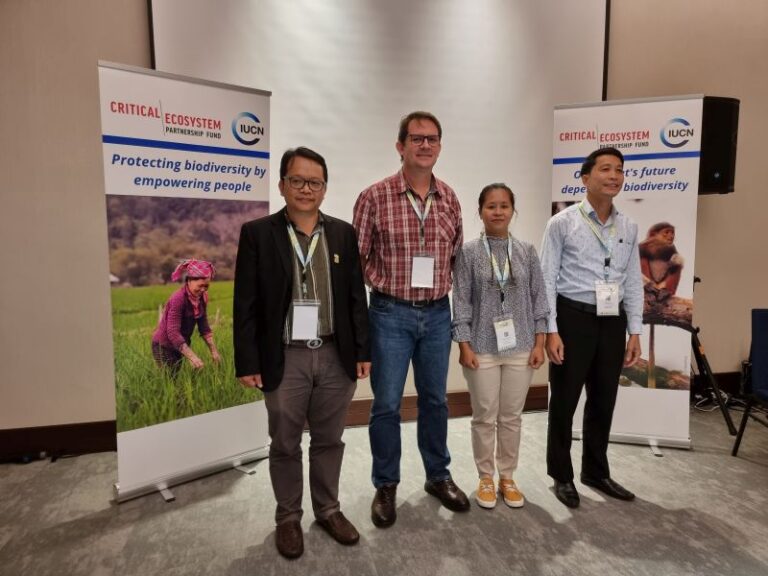These CSOs are working to engage local communities in protecting and conserving biodiversity in protected and conserved areas of the Indo-Burma Biodiversity Hotspot, one of the most biologically significant and most threatened areas on Earth, which urgently needs to accelerate conservation efforts.
2nd Asian Parks Congress: Parks for Nature and People
Linked to the conference theme “Parks for Nature and People” and in line with APC Working Group 2 “Governance of Protected and Conserved Areas”, side events showcased the efforts of local CSOs working with local communities on the ground to strengthen engagement in protected and conserved areas. Case studies addressed themes on community engagement in the designation, governance and management of protected and conserved areas and provided a backdrop for panel discussions between presenters and audience participants.
Participants were exposed to “on the ground” models, challenges and lessons learned in implementing community-based approaches in protected and conservation areas, and local CSOs were given the opportunity to raise awareness of their work and build networks with other practitioners.
The event began with presentations by CSOs including NatureLife Cambodia, Myanmar Biodiversity and Nature Conservation Association (BANCA) and Green Viet Vietnam, followed by a discussion with the audience.
Nature Life Cambodia
NatureLife Cambodia is a national nature conservation organisation working to conserve biodiversity by building the capacity of local communities to sustainably manage natural resources for the benefit of all. In relation to the side event’s theme on community engagement in protected and conserved areas, the CEPF-supported NatureLife project at Stung Sen Ramsar Site was selected as it aims to improve the capacity of local communities to manage natural resources and improve local livelihoods.
“Local people have lived in their communities for a long time and depend on natural resources for their livelihoods, so they have a deep understanding of local concerns and should be directly involved in the establishment, governance and management of community protected areas,” said Vosak Bou, CEO of Nature Life Cambodia.
Banca
BANCA is one of Myanmar’s leading national organizations for biodiversity and nature conservation. Its mission is to partner with local conservation groups and community-based organizations to effectively manage and protect protected areas and safeguard nature and biodiversity. BANCA’s CEPF-supported project was selected as the focal project for the side event because it highlights the role that local communities play in protecting three critically threatened species in Myanmar.
BANCA Secretary-General Thiri Day Wee Aung stressed the need to involve local communities in conservation activities and raise awareness of conservation issues. “It is important to do this in the right language, which will help build trust among community members,” said Thiri.
Green Vietnam
GreenViet works to protect important ecosystems and endangered species in the Central and Central Highlands regions. The CEPF-supported GreenViet project, which works to protect the grey-shanked douc by supporting species defenders in Tam My Thai, Vietnam, was featured at the side event.
Tran Huu Vy, Director of the Green Viet Biodiversity Conservation Centre, stressed: “Involving local communities in monitoring and protecting protected areas is very important because management strategies need to take into account local knowledge and practices. Local communities want to protect their forests and conserve the biodiversity where they live.”
Mr. Alex McWilliam, Senior Species Programme Officer, IUCN Asia and Manager of CEPF Regional Implementation Team (RIT) for the Indo-Burma Hotspot, concluded the session with his closing remarks, further emphasizing that “Building trust with communities is a long and challenging process, but it is fundamental to engaging communities in protected and conserved areas. Local civil society organisations provide a vital link between local communities and other stakeholders, helping to ensure successful community-based approaches to conservation. Now is the time to scale up and extend these approaches and ensure meaningful local community participation and ownership.”
About CEPF
CEPF supports non-governmental organizations, indigenous groups, universities and the private sector to protect the world’s biodiversity hotspots and help communities thrive. It is a joint initiative of the French Development Agency, Conservation International, the European Union, the Global Environment Facility, the Government of Japan and the World Bank. In the Indo-Burma Hotspot, it is also supported by the Margaret A. Cargill Foundation. IUCN serves as CEPF’s regional implementing team in the Indo-Burma Hotspot.
For further information, please contact:
Alex McWilliam, IUCN Senior Programme Officer for Asian Species/CEPF RIT Manager for the Indo-Burma Hotspot: Alexander.McWilliam@iucn.org
Noor Ali, IUCN Asia Communications Officer / CEPF RIT India-Burma Hotspot Communications Officer: Noor.ali@iucn.org

